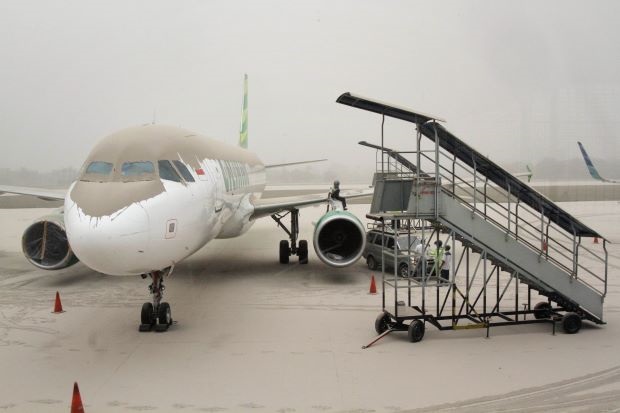In this part, you will tell me what you can see in this picture and what you think is happening in it. After that, I will ask you some questions. Look at the picture carefully. You may take a few moments to think before you start talking.
Are the instructions clear?
SUGGESTED INTERACTION:
ICAO 5: This picture shows me a twin-engined passenger jet probably parked at the gate with chocks on and covered in volcanic ash.
There is an air stair but it’s not connected to the plane, and I can also see an airport service vehicle parked next to the left engine and some ground staff personnel nearby.
There is one of them sitting on the wing and he may be there to provide coating to the engine in order to avoid volcanic ash damages.
As far as I can see, the right engine has a coating and there are cones isolating the area as well.
By looking at the sky, it seems the volcanic ash is still falling and it will take a time to restart the operations.
ICAO 4: This picture shows me a twin-engined passenger jet parked at the gate covered in volcanic ash.
There is a stair next to the aircraft but it’s not connected to the plane and It’s possible to see an airport service vehicle parked next to the left engine and some ground staff workers nearby.
There is a man sitting on the wing and I believe he’s there to cover the engine to avoid volcanic ash damages.
As far as I can see, the right engine has a protection and there are also cones marking the area around the aircraft.
It seems the volcanic ash is still falling and the operation of the airport will take a time to restart.
Examiner: What do you think happened before this picture was taken?
SUGGESTED INTERACTION:
ICAO 5: I believe the volcanic ash fall was informed and all the airplanes had to land as quick as possible to avoid volcanic ash damages, all the passengers disembarked and the operations stopped for undetermined time.
ICAO 4: Before this picture was taken I believe the volcanic ash fall was informed and all the airplanes had to land quickly and the airport operations had to stop.
Examiner: What do you think will happen next?
SUGGESTED INTERACTION:
ICAO 5: As soon as the volcanic ash stops falling, the airport will face a hard work to lead with so much volcanic ash like this and I believe they will start the cleaning up and maintenance checks on the aircraft.
ICAO 4: As soon as the volcanic ash stops falling, the airport workers will have to clean all the volcanic ashes and start the maintenance checks on the aircraft.
Examiner: How can volcanic ash affect aircraft equipment?
SUGGESTED INTERACTION:
ICAO 5: Volcanic ash can affect very seriously the aircraft equipment.
It can clog the pitot tubes, scratch the windshield, stuck control surfaces, cause engine flame out and can even bring about cabin contamination affecting the avionics.
ICAO 4: Volcanic ash can clog the pitot tubes, scratch the windshield, stuck the control surfaces, cause engine flame out and can even cause cabin contamination affecting the avionics.
Examiner: What kind of technology is being used nowadays to help pilots avoid volcanic ash?
SUGGESTED INTERACTION:
ICAO 5: Nowadays there is no technology available on board to avoid clouds of volcanic ash but there is Datalink system which can deliver real time messages coming from the airlines on the ground informing about volcanic activity and the possible volcanic clouds ahead.
Pilots can also get information before the flight looking for weather forecast.
ICAO 4: Nowadays there is no technology available on board to avoid clouds of volcanic ash but there is Datalink system which are messages sent by the airlines on the ground informing about volcanic activity and the possible volcanic clouds ahead.
Pilots can also get information before the flight looking for weather forecast..
Now, I am going to read a statement to you and then you will have to tell me to what extent you agree or disagree with it.
“Plumes of volcanic ash are most hazardous for night flights because the ash can scratch cockpit windows and also affect visibility.”
SUGGESTED INTERACTION
ICAO 5: I agree in parts with this statement because volcanic ash can scratch the windshield at any time since it’s in the air, but it can be even more dangerous at night flights because it cannot be seen and when pilots notice the ashes, it’s too late to avoid it because the damages can happen quickly, in a blink of eyes.
ICAO 4: I agree in parts with this statement because volcanic ash can scratch the windshield at any time, but it can be more dangerous at night flights because it cannot be seen.
When pilots notice the ashes, it’s too late to avoid it because the damages can happen quickly.
Se você gostou desse post do Call to Fly, compartilhe utilizando os canais de Mídia!!
Abraço!! Rumo ao topo!
Leandro Araujo
